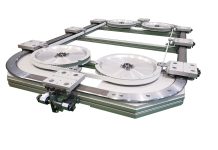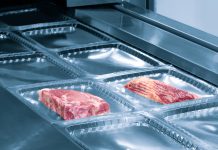
Over the past decade the packaging sector has seen an exponential growth of shrink sleeves in primary packaging: these are plastic heat-shrinkable labels which, thanks to their characteristics, are retracted by means of a heat source, and can perfectly fit any kind of container, jars, bottles, bowls, whether in glass, plastic or other material.
Shrink sleeves are packaging solutions that offer many advantages: they fit any kind of container (unlike paper labels, adhesive labels or roll-fed), they have great visual impact on shelves, by making a product more interesting and attractive, they can be used on containers of different materials and provide an all-round surface for graphics, information, ingredients, legal texts etc., color effects and innovative graphics thanks to the use of opalescent and metallic inks, with mirror effects or matt paints. And again: they protect the content from light, thanks to treatments and inks that make the sleeve a real barrier and protect the container itself, as for example during transports. Sleeves are also a form of security since they can be used also as warranty seals on the containers cap thus guaranteeing the inviolability of the product. In addition they reduce storage: in fact the same bottle allows diversifying references, distributors, brands and production lots. They facilitate disposal and recycling as they have a single packaging material (i.e. PET bottle + PET sleeve). They can be applied before or after filling thanks to resistance against pasteurization (PET). They are modern and innovative solutions with colored and brilliant packaging as there is a lot of space to communicate hints, recipes, ingredients, and captions to customers. Sleeves have a strong resistance to light and water because they are printed inside and therefore they aren’t directly exposed to wear and tear normally resulting from products’ storage and handling.

Sleeves are made from a continuous flat tube made of heat-shrinkable plastic (PET, PVC, Polypropylene) wrapped in a coil, which is cut at a programmable height (or determined by a colored notch) and then slipped on the product with a synchronized movement activated by a photocell that detects its passage. The unit cycle, generally, is controlled by a PLC, in which it is possible to record and modify operating parameters. Some automatic sleeve applicators can also be equipped with a longitudinal drilling device so that consumers can easily tear away the sleeve. Modern machinery can make printed sleeves up to 11 colors thanks to various printing processes: flexo, rotogravure and offset. Once it is fit on the product, the printed film passes into an oven where it is heat-shrunken on the product itself. The heat-shrinking tunnels are available in different versions: by steam, hot air or infrared. Shrinking ovens can be used both into an existing production line and offline for manual applications. The materials used for the labels change according to their use and the result to be obtained: PVC is a good compromise between economy and print result, PET allows meeting the needs of environmental protection and OPS combines the advantages of the previous. One of the novelties is the sleeve in Pla (polylactic acid) or with “paper effect”. In the latter case it is a sleeve that simulates paper, and therefore it gives a more natural effect to the product; using ink and finishes, it gives both visual and tactile effect of a material that doesn’t look like plastic but has the same features of a traditional shrink sleeve.
A growing market

Sleeves represent about 8% of the world production of labels and approximately a fifth of adhesive labels. They are growing steadily in every productive sector, in more recent years, especially in those sectors that are big users of quality adhesive labels, such as food, pharmaceuticals and cosmetics. To emphasize the product on the shelf and catch the consumer’s attention, in fact, an increasing number of companies are moving towards the use of heat-shrinkable sleeves both for marketing reasons (to renew design and therefore increase sales) and to protect the contents from light (e.g. milk, oil and fruit juice sensitive to light exposure). The main producers of films and inks have focused the increasing importance of this sector and are focusing on a continuous search for new materials to meet every need: thanks to an increasing shrinking percentage, sleeves can be applied on containers that were considered an impossible challenge to win. Rotogravure systems allow printing the film internally, thus making the sleeve’s surface shiny and protecting the inks from abrasions and scratches, or externally, in order to apply matt paints to obtain a satin effect. Print quality offers a photographic performance of images, with extensive use of metallic and opalescent inks. The heat-shrinkable warranty seal can be used for any kind of closures and is suitable for all types of containers: it always offers an all-round surface for any opening, brand, production lot and can be fitted with colored tabs. As it is pre-perforated, it ensures easy removal by the user but makes it impossible to be re-used guaranteeing inviolability. Sleeves are widely used also for promotional packages (two packs at best cost or a pack with complementary gadgets, etc) leaving large spaces for texts, brands and ingredients’ visibility, but using printing for events’ advertising and sponsorship. In this case sleeves have the advantage of joining two products with a particularly complex form. For a long time sleeve labeling technology has been used for the customization of bottles, but only recently it is used to customize injection molded containers, because of technological limitations both of containers and labelers. Almost surely sleeve labels will replace stickers, IML labels (In Mould Labelling) and with a good chance even screen printing customization. In many European countries the trend is now clear and this type of label is increasingly growing.



